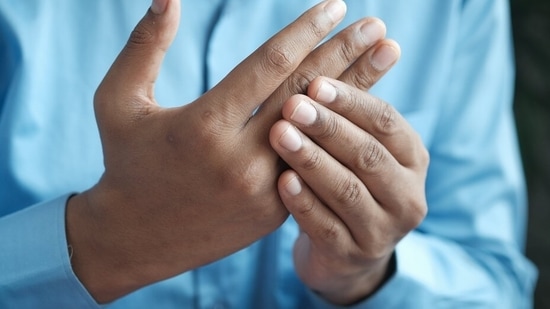From hindustantimes.com
- World Arthritis Day: Not just older people, arthritis can also affect people aged 20-40. While it can't be reversed, people can adopt certain lifestyle measures to slow its progression. A doctor dispels some of the common myths related to arthritis
In osteoarthritis, cartilage that sits between the bones in a joint is damaged while in rheumatoid arthritis, our body's immune system attacks the joints. Apart from damage to the joints, it can also affect muscles, connective tissue, tendons, and fibrous tissue. It tends to appear earlier in life than osteoarthritis, typically between the ages of 20 and 40 years, and it can severely affect day-to-day activities.
Other form of arthritis apart from osteoarthritis and rheumatoid arthritis are juvenile arthritis, spondyloarthropathies, systemic lupus erythematosus, gout, infectious and reactive arthritis, and psoriatic arthritis.
World Arthritis Day is celebrated on October 12 every year to raise awareness in people around the world about the existence and impact of rheumatic and musculoskeletal diseases.
On the occasion of World Arthritis Day, Dr. Shashi Kanth G, Sr. Consultant Orthopaedic Surgeon, Yashoda Hospitals Hyderabad dispels some common myths related to arthritis.
Myth 1: Only older adults develop arthritis
Fact: Arthritis is more common in older adults, but it can affect people of any age. Rheumatoid arthritis tends to present in people aged 20–40.
Myth 2: If your joints hurt, it is arthritis
Fact: This is not true. Not all joint pain is arthritis, and not all joint discomfort is a sign that arthritis will develop later. There are many possible causes of pain in and around the joints, including tendinitis, bursitis, and injuries.
Myth 3: People with arthritis should not exercise
Fact: Exercise is not generally an activity that people with arthritis needs to avoid, although they should speak with their doctor before beginning a regimen. Exercise can help maintain range of motion and strength in the joints.
Exercise and arthritis can and should coexist. People with arthritis who exercise regularly have less pain, more energy, improved sleep, and better day-to-day function. Exercise should be one of the mainstays of treatment for osteoarthritis of the hip and knee.
Myth 4: Heat is better than ice for sore joints
Fact: This is not true. Both ice and heat can soothe sore joints.
Used in the right way, heat can help reduce pain and stiffness in joints and muscles. The cold application can help reduce joint inflammation and swelling.
People should use heat before exercise, when a joint is stiff, and when they experience pain. Cold can also relieve pain, and it might also be useful if the joint is inflamed, particularly if there is swelling after activity.
Myth 5: Arthritis is not preventable
Fact: It is not possible to prevent every case of arthritis, as some risk factors, such as advancing age, are not modifiable. However, people can eliminate or minimize certain risk factors to prevent the onset of arthritis or slow its progression. For instance, people with excess body weight have an increased risk of developing knee osteoarthritis.
Maintaining a moderate weight can lower arthritis risk. Smoking tobacco is also associated with an increased risk of developing rheumatoid arthritis. Quitting smoking will reduce the risk and bring a range of other health benefits. Also, as arthritis can develop following injuries, protecting the joints during sports or other physical activity can help reduce the risk of developing arthritis in later life.
Myth 6: After receiving a diagnosis, there is nothing you can do
Fact: Although there is often no cure for the disease, its course varies depending on the type of arthritis. Medications are available that can help reduce the symptoms of many types of arthritis and slow disease progression.
People can also adopt certain lifestyle measures to slow the progression of some types of arthritis, such as maintaining a moderate weight, quitting smoking, eating a healthy diet, and getting enough sleep.
Myth 7: Weather changes can make arthritis worse
Fact: There is a persistent claim that rain and damp weather makes arthritis symptoms worse. However, it is not conclusive, and the weather does not seem to affect everyone with arthritis.
Despite advances in the medical field, we still have much to learn about arthritis. However, we do know that by maintaining a lifestyle that includes exercise and a nutritious, balanced diet, we can reduce the risk of some types of arthritis and slow their progression. As scientists continue to investigate these conditions, better treatments are sure to arise.

No comments:
Post a Comment